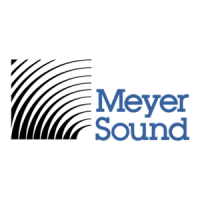3
CHAPTER 1: INTRODUCTION
HOW TO USE THIS ASSEMBLY GUIDE
Make sure to read this assembly guide in its entirety before
configuring a loudspeaker system using pull-back.
In particular, pay close attention to material related to safety
issues. As you read this assembly guide, you will encounter
the following icons for notes, tips, and cautions:
As you read these instructions, you will encounter the fol-
lowing icons for notes, tips, and cautions:
NOTE: A note identifies an important or useful
piece of information relating to the topic under
discussion.
TIP: A tip offers a helpful tip relevant to the topic
at hand.
CAUTION: A caution gives notice that an
action may have serious consequences and
could cause harm to equipment or personnel, or
could cause delays or other problems.
Information and specifications are subject to change.
Updates and supplementary information are available at
www.meyersound.com
.
Meyer Sound Technical Support is available at:
■ Tel: +1 510 486.1166
■ Tel: +1 510 486.0657 (after hours support)
■ Web: www.meyersound.com/support
■ Email: techsupport@meyersound.com
FACTOR OF SAFETY DISCLAIMER
Important: Read Carefully
Rated load capacities of the Meyer Sound rigging assembly
for different splay angle settings are based on testing per-
formed by an independent testing agency, and on 5 to 1
safety limit analysis to ultimate load performed by an inde-
pendent structural engineering firm. The ratings apply to the
Meyer Sound rigging only. You are responsible for the safety
factor required by local law for your installation, and for
determining the adequacy of supporting structure "above
the hook." PERMANENT INSTALLATIONS MUST BE CERTI-
FIED BY THE ENGINEER OF RECORD FOR WIND AND
SEISMIC LOADING.
MAPP assumes the top grid is picked up by a front and rear
motor along the perimeter of the grid, either directly to the
middle pickup points or bridled at 45 degrees or greater to
the grid's outermost pickup points. Other rigging configura-
tions may have reduced load capacity. These cases should
be reviewed by proper personnel to verify load capacities for
alternate configurations.
Bridle angles are measured between the bridle cable and
top grid plane.
Center Bar Pickup Points
MAPP Factor of Safety calculations are made for peripheral
top grid points -- either corner or middle -- depending on
the top grid configuration. Using the center bar pickup
points will result in reduced load capacity. These cases
should be reviewed by proper personnel to validate the con-
figuration.
Pull-Back Load Status
MAPP Load Status -- when using Pull-Back -- additionally
takes into account the Pull-Back Load Status as an addi-
tional pass/fail criteria to determine the overall Load Status
condition. The Vertical Pull-Back Load Status is the pass/fail
criteria. The -10º/+10º status indicators provide the user of
the tolerance that exists to each side of the vertical. For all
purposes Pull-Back should be as close to vertical as possi-
ble as loads will vary. Deviations from a vertical Pull-Back
should be reviewed by proper personnel to verify load
capacities for alternate configurations.

